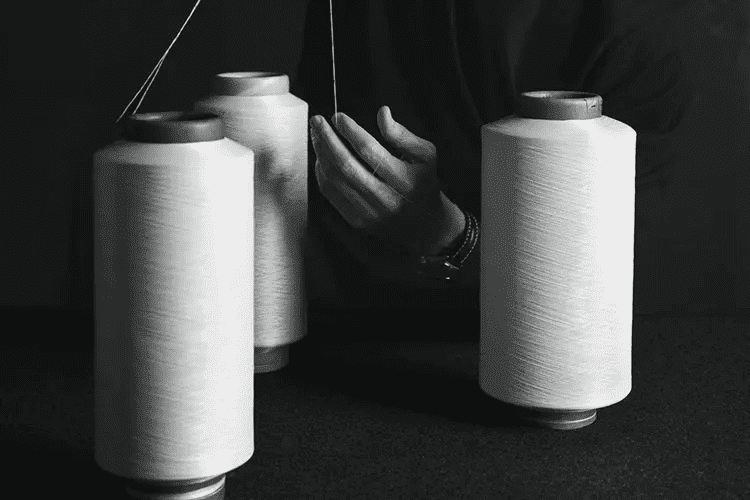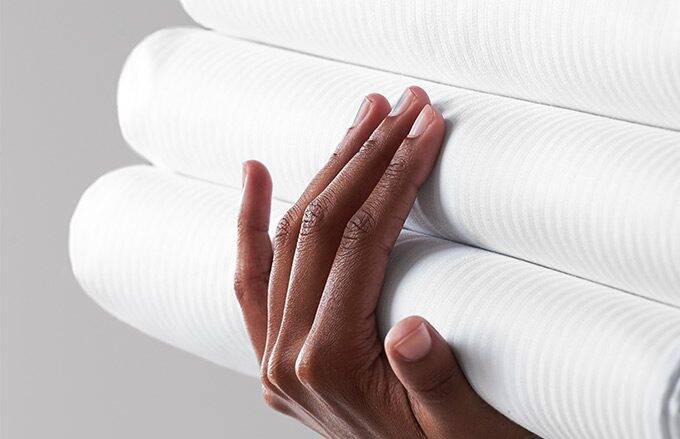August 1, 2023
Does Thread Count Matter? Not Anymore…

What is Thread Count Anyways?
Thread Count is a system of fabric identification that counts the number of vertical and horizontal threads in one square inch. We’ve been trained to think high thread count equals better quality. And in the early days of manufacturing, this was true. However, with modern technology and advancements, can you still trust the thread count printed on your sheet set?
Does Thread Count Still Matter?
The truth is, not anymore. With today’s advanced technology, counting threads in a square inch to determine quality is obsolete.
View our Infographic to get the full story
The Facts on Thread Count
Here’s 4 facts that help explain why thread count is obsolete:
Fact 1
The concept of thread count was created before synthetic fibers (e.g. polyester, acrylic) were invented, making the thread count discussion backward-looking.
Fact 2
Thread count assumes that all the yarns being counted within an inch of fabric are of a single strand, like cotton. Synthetic fibers may be made up of hundreds—even thousands—of strands of yarn, which are twisted together.
Therefore, thread count ignores the high number of individual strands that are present in a synthetic, multifilament yarn.
Fact 3
Many different kinds of fibers make up the fabrics we love and touch every day. Natural fibers like cotton, silk, or wool come from plants or animals and can be delicate. Synthetic fibers like polyester make sheets strong, durable, and keep them looking white and crisp.
The combination of the two types of fibers can give your sheet a soft, comforting feel, with the strength to endure rigorous washing. Our own Centium Core Technology® leverages this combination. In the end, instead of thread count, it’s actually the thread that counts.
Fact 4
Thread count is a figure that’s often manipulated. There’s no governing body or ultimate authority on thread count. People can arrive at thread count by double-counting plied yarns (two or more yarns that are twisted together) or simply overstating the actual physical construction.
What is a good thread count for sheets?
For 100% cotton sheets, thread counts of 200-300 are generally considered good quality. However, cotton has one thread per yarn, while modern synthetic materials can have hundreds of threads twisted together to form one yarn. This can lead to very high thread counts that have little meaning.
In the case of Standard Textile’s ComforTwill® sheets, there are 7,180 individual spun cotton yarns and synthetic filaments per square inch. How could we compare this number to the 200, 250, or even 300 “threads per square inch” that would be counted in a traditionally woven cotton fabric?
Centium Satin™ Sheets
If thread count is out, how do I choose linens for my hotel?
Instead of asking “What’s the thread count?” when considering sheets for your hotel, try asking these questions:
How Do They Feel Against Your Skin?
No amount of math can replace your own sense of touch. Before purchasing new linens, get samples, and make a decision informed by your own personal experience. And don’t stop at the first touch. Run your sample through the laundry a few times and make sure that it still feels good. Anything else is just guessing.
Are They Strong? Are They Durable?
Ask about the tensile strength of your linens, not the thread count. While touch is important, you can save yourself a lot of time by avoiding any products below 50 pounds of tensile strength. We recommend choosing linens that have 80 pounds or higher tensile strength for extra durability and product life.
What’s the Fabric Content?
More cotton equals more comfort. It’s pretty straightforward but depending on the yarn type and weaving methods, 100% cotton can suffer from durability concerns. That’s why you should seek linens that have high cotton content but incorporate some synthetic fiber content for additional strength. We recommend blends with 25–35% polyester for additional strength.
What is the Cost-Per-Use?
Linens that are comfortable and durable is the goal, but another aspect to consider is cost-per-use. Some linens are specially woven to achieve optimal comfort and quality, but at a lower product weight. Some have innovations that shorten drying time during the laundry cycle. Features like these lower the overall cost-per-use compared to other linens, and those cost savings can add up to tens of thousands of dollars per year.
What Do Your Guests Think?
The most important critics of your linens are your guests. Guests have the most contact with linens, and they deserve quality and comfort. If they tell you your sheets don’t feel good, it won’t matter if you tell them about the high thread count.
Put simply, talking about thread count is like talking about vintage hotel room keys. We’ve progressed.
Related Content

The Benefits of 100% Cotton Sheeting
When it comes to creating an unforgettable experience for your guests, every detail counts—from the ambiance of your property to the quality of the amenities you provide. Imagine sinking into a soft, luxurious bed after a long day of travel; it’s these little luxuries that leave a lasting impression. The choice between 100% cotton and…

Is 100% Cotton Sheeting Right for Your Properties?
While 100% cotton bedding certainly sets the bar high for comfort, there are many considerations besides a soft hand when it comes to choosing the right material for your resort, rental, or hotel bedding products.

Beyond Product Cost: How Choosing the Right Linens Can Save Hoteliers Money
Switching to a cheaper product may save in the short-term, but it often costs more in the long run. Here are several costs to consider beyond product cost.